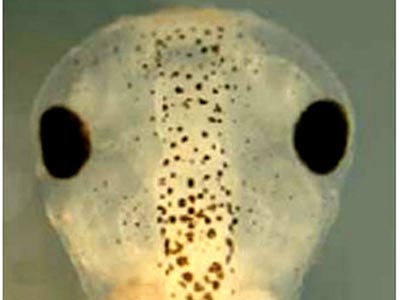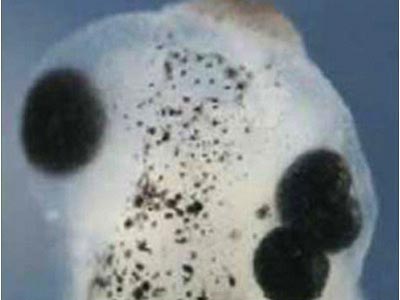Right to create, create ... eyes for creatures
British scientists have injected an enzyme into the frog embryo. Strangely, just inject in which part, the eye makes it. This experiment leads to perspective, replacing the blind for the future .
This experiment was conducted by Professor Nicholas Dale and Elizabeth Jones of the University of Warwick, England. The team used 3 enzymes, called extracellular enzymes: E-NTPDase1, E-NTPDase2 and E-NTPDase3 to create frog embryos. The test was conducted at one of the earliest stages of embryo development.
The team was surprised to see that after injecting the E-NTPDase2 cells that form the head of the tadpole, the structures of the eyes were formed. In the end, the frog tad has an extra . an eye! Even stranger, when this enzyme is introduced into some cells in other parts of the embryo, eye-like structures can also grow there.

Eye development in the normal frog tadpole and without the extracellular enzyme injection (Photo: Nature).

After injecting E-NTPDase2 into frog embryos, the tadpole was born with . an eye (Photo: Nature)
As a result, frog tadpoles have more ' stray eyes' on the hips, abdomen and even along its tail. In short, the team can create tadpole eyes in various parts of its body.
Explaining this phenomenon in terms of scientific principles, the research team said that the E-NTPDase2 enzyme has the ability to cling to ATP - an important molecule that functions to transmit energy and signals - to convert stool This element becomes another molecule, named ADP . And when E-NTPDase2 helps cells produce higher ADP levels than normal, it stimulates eye development.
In the words of science, ' E-NTPDase2 has triggered frog embryo ophthalmic mechanism '.
The team estimates that the mechanism of such eye development is also possible in humans and other ocular animals . Since then, they have come to anticipate that once they produce eyeballs from stem cells in the lab, it is possible in the future to replace those with serious eye injuries.
The study was published in Nature , a prestigious journal of international science, published on October 25, 2007, and later, the news was published by scientific news agencies and magazines such as AFP. , Live Science, PhysOrg reports.
Warwich University, where the two professors said the experiment, also issued a press release, emphasizing the experiment opened a new way of research to create human eyeballs, or at least tissues. for transplants for visually impaired people '.
Enzymes are proteins that act as catalysts, helping to make chemical reactions faster.Extracellular enzymes (ectoenzymes or exoenzymes or extracellular enzymes) are any group of enzymes that are released from cells in which they are produced in the environment surrounding the cell.In other words, these are enzymes that work outside the cells that produce them.

Enzyme (Photo: Metallo.scripps.edu)
- 19 most obsessive eyes in the history of world photography
- Fifty facts about eyes
- I know why my eyes are as big as a basketball
- The mystery of eyes 'killing people with just one look'
- Interesting things about the eyes
- Strange possibilities of eyes
- Without instruments, humans can create music with eye movement
- People use fluent eyes language from birth
- 7 ways to keep your eyes healthy
- Detect the bizarre red creature without eyes, mouth
- Discovering strange creatures without brains, one eye can eat meat
- Wonder the lovely squid like little pig
 Why do potatoes have eyes?
Why do potatoes have eyes? 'Tragedy' the world's largest carnivorous life: Death becomes ... public toilet
'Tragedy' the world's largest carnivorous life: Death becomes ... public toilet Tomatoes were once considered 'poisonous' for 200 years
Tomatoes were once considered 'poisonous' for 200 years Detecting microscopic parasites on human face
Detecting microscopic parasites on human face